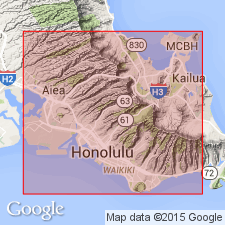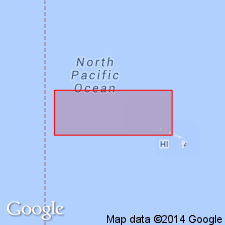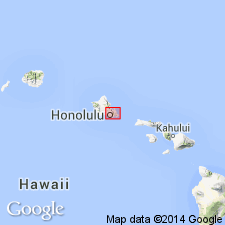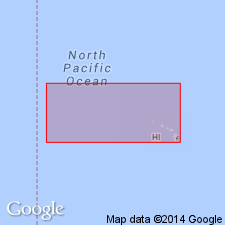
- Usage in publication:
-
- Mauumae ash and basalt
- Modifications:
-
- First used
- AAPG geologic province:
-
- Oahu
Summary:
Named for Mauumae Crater, Diamond Head district [Honolulu quad] Island of Oahu. Consists of materials ranging from medium textured black ash through coarser agglomerate and rhyoclastic lava to flow lava. Figure map shows location in Diamond Head district. Unconformably overlies Koolau basalt.
Source: GNU records (USGS DDS-6; Menlo GNULEX).

- Usage in publication:
-
- Mauumae volcanics*
- Modifications:
-
- Named
- Dominant lithology:
-
- Volcanics
- AAPG geologic province:
-
- Oahu
Summary:
Mauumae ash and basalt of Wentworth (1926) named Mauumae volcanics. Included as unit in middle part of Honolulu volcanic series. Made up entirely of firefountain products and small trickles of lava flow of nepheline basalt. Forms hill about 50 ft high on crest of wall of Palolo Valley. Correlated with Kaimuki volcanics on lithologic basis and therefore assigned to Waipio stand of sea. Assigned middle(?) and late Pleistocene age.
Source: GNU records (USGS DDS-6; Menlo GNULEX).

- Usage in publication:
-
- Mauumae volcanics*
- Modifications:
-
- Age modified
- AAPG geologic province:
-
- Oahu
Summary:
Mauumae nepheline basalt and associated pyroclastics are tentatively correlated with Laie stand of sea because no appreciable unconformity can be found between them and Kaimuki and Diamond Head rocks of Waipio age. Rocks of Kapahulu quarry show pillow structure suggesting submarine movement and eruption during last high stand of sea preceding subaerial Kaimuki and Diamond Head eruptions.
Source: GNU records (USGS DDS-6; Menlo GNULEX).

- Usage in publication:
-
- Mauumae volcanics*
- Modifications:
-
- Age modified
- AAPG geologic province:
-
- Oahu
Summary:
Exposed over area of about 0.05 sq mi on southern side of Koolau Range, 10 mi west of Makapuu Head. In drillhole at Liliuokalini School lava flow is more than 151 ft thick. In drillhole underlies 1 ft of grayish-brown basalt probably from Diamond Head and 49 ft of Kaimuki basalt. Assigned late Pleistocene age based on tentative correlation with plus 70-ft (Laie) stand of sea (Winchell, 1947).
Source: GNU records (USGS DDS-6; Menlo GNULEX).

- Usage in publication:
-
- Mauumae Volcanics*
- Modifications:
-
- Geochronologic dating
- AAPG geologic province:
-
- Oahu
Summary:
K-Ar age on nepheline basalt from Mauumae vent gave 0.43 +/1 0.04 Ma.
Source: GNU records (USGS DDS-6; Menlo GNULEX).

- Usage in publication:
-
- Mauumae Volcanics†
- Modifications:
-
- Abandoned
- AAPG geologic province:
-
- Oahu
Summary:
Mauumae Volcanics (Stearns, IN Stearns and Vaksvik, 1935) abandoned as formally named unit and called Mauumae flow (and associated cone), informal unit of Honolulu Volcanics.
Source: GNU records (USGS DDS-6; Menlo GNULEX).
For more information, please contact Nancy Stamm, Geologic Names Committee Secretary.
Asterisk (*) indicates published by U.S. Geological Survey authors.
"No current usage" (†) implies that a name has been abandoned or has fallen into disuse. Former usage and, if known, replacement name given in parentheses ( ).
Slash (/) indicates name conflicts with nomenclatural guidelines (CSN, 1933; ACSN, 1961, 1970; NACSN, 1983, 2005, 2021). May be explained within brackets ([ ]).

